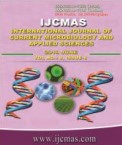


 National Academy of Agricultural Sciences (NAAS)
National Academy of Agricultural Sciences (NAAS)

|
PRINT ISSN : 2319-7692
Online ISSN : 2319-7706 Issues : 12 per year Publisher : Excellent Publishers Email : editorijcmas@gmail.com / submit@ijcmas.com Editor-in-chief: Dr.M.Prakash Index Copernicus ICV 2018: 95.39 NAAS RATING 2020: 5.38 |
The objective of this study was to assess diagnostic accuracy of the ECG localization of culprit vessel occlusion site and compare it with coronary angiographic findings. This study analyzed 180 cases that came with acute myocardial infarction to cardiology department of Tanta University Hospital in a period from the first of May 2016 up to the end of May 2018. Typical chest pain lasting more than 30 minutes accompanied by ST-elevation at the J-point in two contiguous leads associated with elevation of cardiac markers were included in this study but we exclude patients with Previous history of myocardial infarction, Previous history of coronary artery bypass graft (CABG) surgery, ECG evidence of left bundle branch block (LBBB), pre-excitation, paced rhythm and acute coronary syndrome other than STEMI. Among all myocardial infarction patients, ECG shows left anterior descending (LAD) branch affection in 116/180 patients (64.44%), which was as follow; 13.33% proximal to S1, 6.67% proximal to D1 and 44.44% distal to D1. Right coronary artery (RCA) presented in 56/180 patients (31.11%) as follow; 11.11% proximal to RV branch and 20% distal to RV branch. Left circumflex artery (LCX) is represented only in 8/180 patients (4.44%). ECG is an easily and widely available inexpensive tool which helps in the routine clinical practice to categorize and optimize STEMI patients by detection of artery occluded into either right coronary artery or left anterior descending coronary artery or left circumflex coronary artery as the infarcted related culprit vessel and predict the possible complication
 |
 |
 |
 |
 |